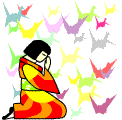Explaining Japan to Americans
Created | Updated Jan 11, 2007

My Irish Husband Tony and I recently were privileged to sail on Semester at Sea to Asia. In addition to teaching two classes of university students, I wrote a weekly blog to my fellow Americans. This is the last entry, about Japan.
Saturday we sailed through Japan's Inland Sea, past uninhabited islands and big cities, and docked Sunday morning in downtown Kobe, Japan. Picture a country with half the US population shoved into California — but just the mountainous part. And you dropped nuclear bombs on two of their largest cities but, within 40 years, they became the world's second largest economy.
Our visit to the peace memorial at Hiroshima left at 6 am for a five-hour bus trip through Pennsylvania-like mountain tunnels. Considering the Japanese suffered nuclear radiation, getting up at 5 am wasn't much of a sacrifice.
Our students had folded 1000 origami cranes to hang at the memorial for a 10-year-old girl who died from leukaemia after the blast. When our trip leader, Professor Judit, found out on the bus that there should be an accompanying ceremony, she pulled together a moving sermon. It was hot, standing there in the August sun. But that didn't match the 5800C temperature when the first nuclear bomb exploded there 61 years and 1 day before. No one complained on the long bus trip back that night.

My Irish Husband Tony and I signed up for the 'Home Visit' programme, and our hostess, Mrs Nakahata, met us at the subway station (Gee, how did she pick us out?). She took us by taxi to her high-rise apartment, clinging to the side of a San Francisco-steep mountain looking out over the bay. We could hear the crickets around her building and see our ship from her living room.
During our afternoon together, she showed us her collection of brochures about English country garden tours and we invited her to visit us in Birmingham (she likes cats). She was born during the war, but she didn't look any older than us aging baby boomers. Japanese women have the longest life expectancy on earth so, at 62, she still has a ways to go.
When she was an infant, her family home in Osaka burned. She moved to a nearby city where a couple adopted her and raised her with their own children. Her dark eyes looked away as she said of her adoptive mother, 'If it weren't for her, I am not here. I am not here.'
Thanks to this couple, she had attended university, taught school, married a teacher who became a government worker and school principal, and raised three children who have families and jobs of their own. She has visited America and Europe. What a Japan she has witnessed in this past 60 years.

Today, last port, last day, I went with another professor and his political science students to the University of Kobe, carved out of the same mountainside as Mrs Nakahata's apartment building, with the same chirping crickets for background. Professor Rieko Kage of their new law school talked to us about domestic politics under the popular Prime Minister with the great hair, Junichiro Koizumi.
Dr Kage arranged for four of her students to join us for lunch, two Japanese, one from Paraguay, one from Sweden. Annemarie and Bjorn are among the 10% non-Japanese in the University's 10,000-strong student body. Most are from Asia; only 300 are Western. They study Japanese law, read Japanese textbooks and take their tests in Japanese. Annamarie said Japan attracted her with the best financial aid for international students.
With the lowest birth rate of any industrialized country, Japan is worried about who will support those aging women. Immigration to Japan? Walking the crowded and interesting streets of Kobe, I felt as though two siblings locked in a closet had developed this culture. They eventually passed their fascinating language and rituals on to 127 million descendants, but outsiders have a hard time decoding them. The Japanese take in Western concepts, but they don't give up much in return.
For an American living in Europe, it's hard to imagine a country loosening its immigration laws to attract workers. Making it easier for foreigners to study at university sounds like a good strategy. After Annamarie gave us a campus tour, partly in Spanish, we got back onto our bus to wind down the steep streets, back to our ship for the last time, in the last port, on our last day.
Last night Tony's first grandson was born. Dallan Brian Dixon Cusack came into the world in Ireland, not at war with anyone. His immediate family, including his eight-year-old sister, Erin, have all visited America and can legally live, work, and study in all 25 European countries. His grandfather is on a ship, under a bright full moon, sailing home from Japan.
Welcome to this world, Dallan. Where will you go?
Thanks for reading.

The Explaining to Americans Archive
